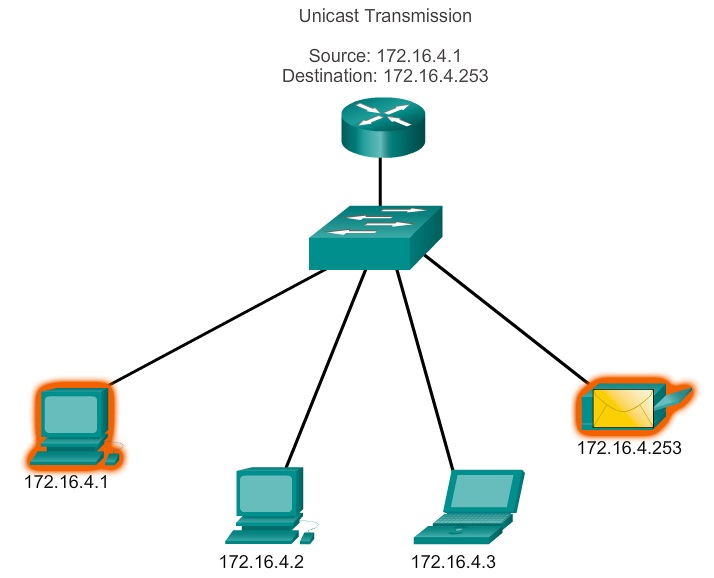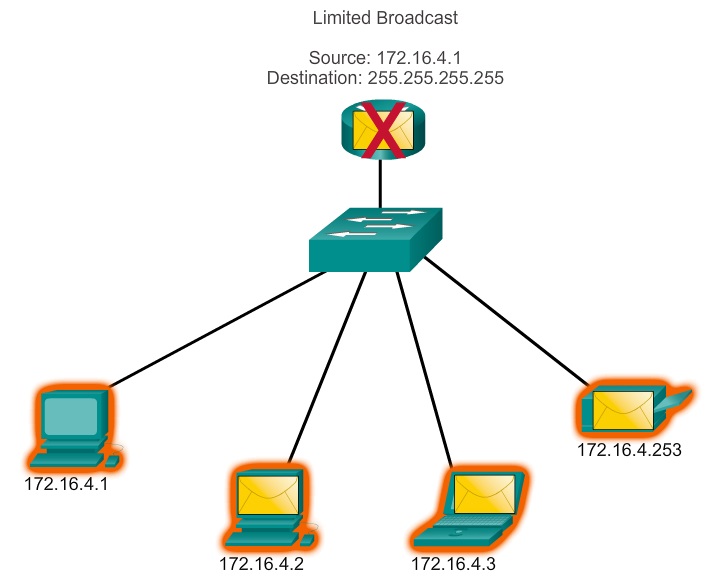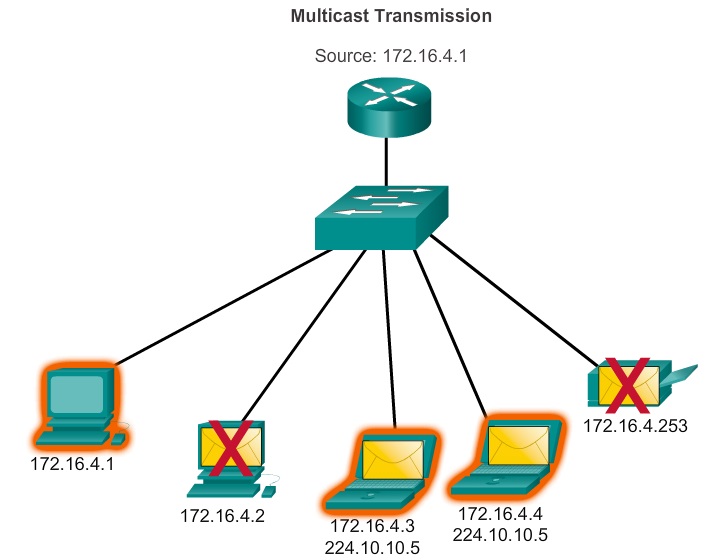IPv4 Unicast, Broadcast, and Multicast
In an IPv4 network, the hosts can communicate one of three ways:
- Unicast – The process of sending a packet from one host to an individual host
- Broadcast – The process of sending a packet from one host to all hosts in the network
- Multicast – The process of sending a packet from one host to a selected group of hosts, possibly in different networks
These three types of communication are used for different purposes in data networks. In all three cases, the IPv4 address of the originating host is placed in the packet header as the source address.
Unicast Traffic
Unicast communication is used for normal host-to-host communication in both a client/server and a peer-to-peer network. Unicast packets use the addresses of the destination device as the destination address and can be routed through an internetwork.
In an IPv4 network, the unicast addresses applied to an end device is referred to as the host address. For unicast communication, the addresses assigned to the two end devices are used as the source and destination IPv4 addresses. During the encapsulation process, the source host places its IPv4 address in the unicast packet header as the source address and the IPv4 address of the destination host in the packet header as the destination address. Regardless of whether the destination specified a packet is a unicast, broadcast or multicast; the source address of any packet is always the unicast address of the originating host.
IPv4 host addresses are unicast addresses and are in the address range of 0.0.0.0 to 223.255.255.255. However, within this range are many addresses that are reserved for special purposes.
Broadcast Transmission
Broadcast traffic is used to send packets to all hosts in the network using the broadcast address for the network. With a broadcast, the packet contains a destination IP address with all ones (1s) in the host portion. This means that all hosts on that local network (broadcast domain) will receive and look at the packet. Many network protocols, such as DHCP, use broadcasts. When a host receives a packet sent to the network broadcast address, the host processes the packet as it would a packet addressed to its unicast address.
Some examples for using broadcast transmission are:
- Mapping upper layer addresses to lower layer addresses
- Requesting an address
- Unlike unicast, where the packets can be routed throughout the internetwork, broadcast packets are usually restricted to the local network. This restriction is dependent on the configuration of the gateway router and the type of broadcast. There are two types of broadcasts: directed broadcast and limited broadcast.
Directed Broadcast
A directed broadcast is sent to all hosts on a specific network. This type of broadcast is useful for sending a broadcast to all hosts on a non-local network. For example, for a host outside of the 172.16.4.0/24 network to communicate with all of the hosts within that network, the destination address of the packet would be 172.16.4.255. Although routers do not forward directed broadcasts by default, they may be configured to do so.
Limited Broadcast
The limited broadcast is used for communication that is limited to the hosts on the local network. These packets always use a destination IPv4 address 255.255.255.255. Routers do not forward a limited broadcast. For this reason, an IPv4 network is also referred to as a broadcast domain. Routers form the boundary for a broadcast domain.
As an example, a host within the 172.16.4.0/24 network would broadcast to all hosts in its network using a packet with a destination address of 255.255.255.255.
When a packet is broadcast, it uses resources on the network and causes every receiving host on the network to process the packet. Therefore, broadcast traffic should be limited so that it does not adversely affect performance of the network or devices. Because routers separate broadcast domains, subdividing networks with excessive broadcast traffic can improve network performance.
Multicast Transmission
Multicast transmission is designed to conserve the bandwidth of an IPv4 network. It reduces traffic by allowing a host to send a single packet to a selected set of hosts that are part of a subscribing multicast group. To reach multiple destination hosts using unicast communication, a source host would need to send an individual packet addressed to each host. With multicast, the source host can send a single packet that can reach thousands of destination hosts. The internetwork’s responsibility is to replicate the multicast flows in an efficient manner so that they reach only their intended recipients.
Some examples of multicast transmission are:
- Video and audio broadcasts
- Routing information exchange by routing protocols
- Distribution of software
- Remote gaming
Multicast Addresses
IPv4 has a block of addresses reserved for addressing multicast groups. This address range is 224.0.0.0 to 239.255.255.255. The multicast address range is subdivided into different types of addresses: reserved link local addresses and globally scoped addresses. One additional type of multicast address is the administratively scoped addresses, also called limited scope addresses.
The IPv4 multicast addresses 224.0.0.0 to 224.0.0.255 are reserved link local addresses. These addresses are to be used for multicast groups on a local network. A router connected to the local network recognizes that these packets are addressed to a link-local multicast group and never forwards them further. A typical use of reserved link-local addresses is in routing protocols using multicast transmission to exchange routing information.
The globally scoped addresses are 224.0.1.0 to 238.255.255.255. They may be used to multicast data across the Internet. For example, 224.0.1.1 has been reserved for the Network Time Protocol (NTP) to synchronize the time-of-day clocks of network devices.
Multicast Clients
Hosts that receive particular multicast data are called multicast clients. The multicast clients use services requested by a client program to subscribe to the multicast group.
Each multicast group is represented by a single IPv4 multicast destination address. When an IPv4 host subscribes to a multicast group, the host processes packets addressed to this multicast address and packets addressed to its uniquely allocated unicast address.
Thanks, If you like this tutorial please share this article to your friends in FB, Twitter,







